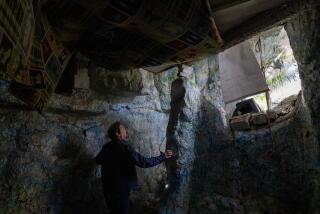Governor’s proposal to sell Ramirez Canyon parkland meets tough opposition
The 22-acre Malibu ranch with rolling meadows, burbling creeks and homes customized by Barbra Streisand may be a lovely location for weddings or afternoon tea.
But Gov. Jerry Brown says state taxpayers have no business owning it, and his proposal to sell the government property in Ramirez Canyon is reverberating from the corridors of Sacramento to the storied seaside colony.
The governor has injected himself into an 18-year battle involving Streisand, the city of Malibu and the Santa Monica Mountains Conservancy, a quasi-autonomous state agency Brown created in 1980 during his first stint as governor. The group, which has rented out the ranch for private events and invites hikers and campers to roam the property, has become one of the largest owners of parkland in Southern California.
The backlash Brown sparked when he tucked his sale proposal deep in the revised budget he unveiled earlier this month highlights the tangled web that can develop when officials try to sell state properties for the money they might bring in. In the end, many such proposals founder because of opposition from local or even state interests.
Brown’s predecessor, Gov. Arnold Schwarzenegger, was unable to sell the Orange County Fairgrounds and San Quentin State Prison amid local opposition. He couldn’t unload a small parcel that California owns in Tahiti after lawmakers bowed to objections from officials in the state university system, which uses it for research. And the multimillion-dollar sale of state office buildings he negotiated has since unraveled.
The state is even hanging onto a strip mall in San Rafael that houses a massage parlor. The Department of Transportation, which owns the property and serves as landlord to the massage parlor, opposed sale plans in 2004 because the area was mired in construction.
Now Brown is wading into the real estate business. Among the other properties he wants to unload are a golf course in the Oakland hills, a building that contains a Sacramento watering hole popular with politicians, and the Los Angeles Memorial Coliseum, the last of which Schwarzenegger also tried unsuccessfully to unload. But the Malibu property is the lightning rod at the moment.
Brown spokeswoman Elizabeth Ashford said the place is for sale because it “does not serve any essential state function. The state should not be the landlord for a place that hosts mountain retreats.”
The conservancy objects to the sale, saying the land is a vital piece of the park system it has worked to build over the last three decades.
The group’s executive director, Joseph T. Edmiston, who through a spokeswoman declined to comment for this article, has defended his agency’s use of the property. He and his supporters have said criticism of the conservancy is drummed up by elitist area residents who consistently act to keep the public out of their scenic canyon.
Streisand donated the land to the conservancy in 1993, a gift valued then at $15 million. In exchange, the conservancy agreed to use it as an environmental think tank and retreat center that would bear her name. Those plans were scrapped amid financial setbacks at the conservancy, whose relationship with Streisand soured. The group turned one of the homes into its executive headquarters, opened the land to overnight campers and rented the property out for events.
Neighborhood resident Rick Mullens said traffic from the parties clogs the narrow canyon road and can block the lone escape route in fire-prone Malibu. The property “should not be used as a commercial space,” Mullens said, “and that’s what they’re doing.”
Streisand, who now lives a few miles away, has sided with the neighbors and demanded that her name no longer be affiliated with the property. She applauds Brown’s sale plan.
“I understand Gov. Brown’s tough decision given the severe budget shortfalls that California is facing,” she said in a statement. “I only hope that there is little disruption to the residents of Ramirez Canyon through this potential transition and that whatever entity does purchase the land and the homes on it, will preserve its special habitat.”
Edmiston has feuded for years with California’s departments of finance and resources over his aggressive pursuit of park land, independent of any given administration’s wishes. The state’s bid to sell the Malibu compound has brought the long-simmering conflicts back to Sacramento.
Shortly after Brown’s plan became public, the head of the conservancy’s board of directors, Antonio Gonzalez, released a statement asserting that recent zoning changes to the property have rendered it virtually worthless on the open market. The houses can no longer be used as full-time residences, and the land must be preserved as open space, according to rules adopted by the California Coastal Commission last year.
“When all the facts are known, I think it is likely that the state will reconsider the proposal,” Gonzalez said.
State Assembly Budget Committee Chairman Bob Blumenfield (D-Woodland Hills), a former director of governmental affairs for the conservancy who used to work at the disputed property, said the governor’s plan would probably die in the Legislature. “It doesn’t make any sense,” he said.
Blumenfield led a successful Assembly subcommittee effort last week to reject the governor’s proposal. Administration officials said they would press on with it anyway as budget negotiations continue, but the vote suggests that finding legislative support may be every bit as difficult as marshaling agreement to raise taxes or cut certain social programs.
Ashford said there is plenty of time to persuade lawmakers. “This process is just beginning.”
More to Read
Start your day right
Sign up for Essential California for news, features and recommendations from the L.A. Times and beyond in your inbox six days a week.
You may occasionally receive promotional content from the Los Angeles Times.






